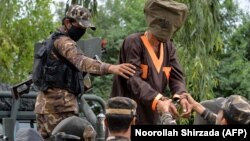Nearly two decades after a major U.S.-led military campaign toppled Afghanistan’s hard-line Taliban regime for hosting Al-Qaeda, senior U.S. and NATO officials are saying that the ultra-radical Islamic State (IS) militants in Afghanistan are a major threat capable of inspiring attacks in the West.
Army General Austin Miller, the top U.S. and NATO military commander in Afghanistan, described the IS affiliates in the country as “a problem to all of us.”
He concurred with recent reported intelligence assessment that IS militants could plan and stage attacks in Europe and the United States. “I think they're a very dangerous group internal to Afghanistan, certainly to the region as well as Europe and the United States of America,” he told Radio Free Afghanistan. The U.S. military estimates that there are about 2,000 IS fighters in Afghanistan.
NATO chief Jens Stoltenberg agreed in highlighting the dangers posed by IS in Afghanistan. "Daesh lost the caliphate in Iraq and Syria, and they [will] try to re-establish the caliphate in Afghanistan. And we must just prevent that from happening,” he said while referring to IS by its Arabic acronym.
British diplomat Nicholas Kay, NATO’s senior civilian representative in Afghanistan, also urges taking the IS threat seriously. “The presence of IS Khorasan in Afghanistan is a threat and danger not just within Afghanistan but potentially internationally, as well,” he said.
Security authorities around the globe are arresting terrorist suspects linked to IS in Afghanistan. On July 2, police in Australia arrested three men in connection to a plot to attack police and defense buildings, courts, churches, and diplomatic missions in Sydney. One of the suspects is believed to be preparing to enter Afghanistan for the purpose of engaging in hostile activities on behalf of the Islamic State group, according to Australian Federal Police Assistant Commissioner Ian McCartney.
In June, the Associated Press reported that at least eight arrests in the United States were linked to the IS affiliate in Afghanistan. These include an 18-year-old Texan man, Martin Azizi-Yarand, who reportedly masterminded an attack on a local mall in 2018 and was sentenced to prison for 20 years in April. Citing anonymous intelligence sources, the report said that Rakhmat Akilov, 39, from Uzbekistan had links with IS in Afghanistan. Akilov plowed a truck into pedestrians in Stockholm in 2017.
Michael Kugleman, a South Asia analyst at the Wilson Center think tank in Washington, says the U.S. and NATO assessments of IS threats in Afghanistan have become strikingly more alarming in recent months. “What is so worrisome about ISIS is that even after getting hit hard by Afghan and U.S. air power for several years, it has remained resilient and potent,” he told RFE/RL’s Gandhara website.
Kugleman, however, argues that the Taliban pose a more serious threat in Afghanistan. “I don’t think we should overstate the danger posed by IS in Afghanistan; based on reach, resources, and overall strength, the Taliban continues to be the more serious threat,” he said.
London-based Afghan journalist Sami Yousafzai sees IS as struggling in Afghanistan. “The Afghan government is against Daesh. The Taliban are against Daesh,” he noted. “The third problem of Daesh in Afghanistan is that the group is in a clash with the culture and beliefs of the people of Afghanistan.”
After its emergence in early 2015, the IS branch in Afghanistan branded itself as the Khorasan Province. Soon afterward, the militants poured into several districts of eastern Nangarhar Province bordering Pakistan, which eventually prompted several large Afghan and U.S. military offensives.
In April 2017, the U.S. military dropped its largest non-nuclear bombs, called “the mother of all bombs,” on IS hideouts in Nangarhar’s remote Achin district. So far, the group has defied repeated claims by Afghan and U.S. officials who declared it to be on the wane. The resilient group appears to have extended to neighboring Kunar Province, where officials see its numbers mounting to more than 400. In May, Kunar Governor Abdul Satar Mirzakwal claimed that IS fighters had failed in an attempt to carve a territorial corridor linking Kunar to the northeastern province of Badakhshan through Nuristan by capturing territories in the three provinces.
Afghanistan’s major near neighbor, Russia, is also worried about the IS threat. In May, Alexander Bortnikov, head of Russia’s Federal Security Service (FSB), said almost 5,000 IS fighters were amassed on Afghanistan’s northern borders with Central Asia.
Beyond the fighting in eastern and northern Afghan provinces, IS has claimed credit for several high-profile attacks, including in the capital, Kabul. In April, at least five militants stormed the 18-story building of the Telecommunications Ministry in Kabul. At least seven people, including four civilians and three police, were killed.
Over the years, the Taliban too have fought IS militants in various regions of Afghanistan including Kunar and Nangarhar provinces in the east, Zabul in the south, and Jowzjan in the north.
While the Taliban have been effective in countering IS clusters, it remains to be seen whether they can guarantee that IS will not pose a threat to international security and would not be able to use Afghan soil for attacking Western nations. The ongoing peace negotiations between the Taliban and Washington will require the hard-line movement to agree to verifiable counterterrorism assurances in return for an international troop withdrawal, NATO officials say.
Kugleman, however, is concerned that any peace deal with the Taliban might push hard-line Taliban militants to switch allegiance to IS.
“In effect, a Taliban peace deal could make IS stronger, and Taliban attempts to combat it could grow more difficult,” he noted.







